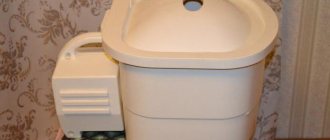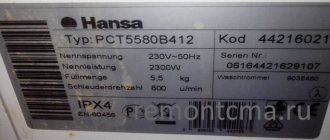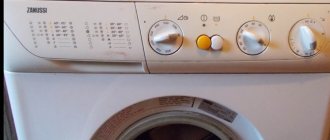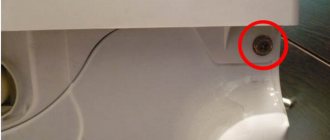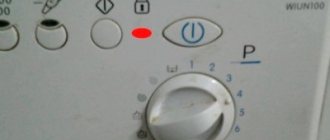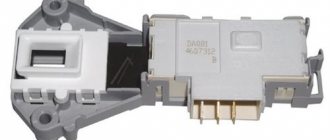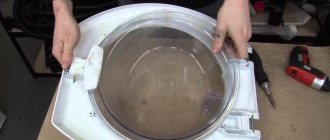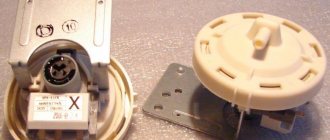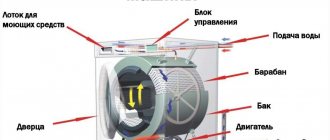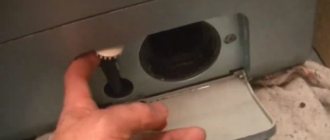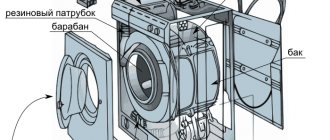The washing machine lock is not the most complicated device, but without it, washing is impossible.
It is needed to block and seal the hatch during the process of washing, rinsing and spinning clothes. This device is designed to provide reliable automatic protection against inadvertent opening of the door and, in the event of a breakdown, stops the washing program. If the door locking device malfunctions and wears out, it requires repair or replacement of the lock on the washing machine.
Device
Note that there are a large number of variations of locks. Manufacturers of washing machines install different locks on their models, which differ in shape, size, and method of fastening. They also differ in their operating principles. There are mainly two types used:
Thermal UBL
At the heart of the thermal lock is an RTS resistor and (or) a bimetallic plate. After closing the hatch and starting the washing program, a voltage of 220 volts is supplied to the resistor. It begins to heat up quickly and simultaneously heats the plate, which bends. As a result, it blocks the hatch hook using a latch, preventing it from opening during the wash cycle. The bimetallic plate also closes the control contact, as a result of which the selected program begins to be executed.
The diagram and principle of operation of such a lock is shown in the figure below.
Note that markings in the form of letters: N, L and C are often present on the UBL contacts, which makes it easier to check. Instead of an RTS thermistor, a winding made of high-resistance wire can be used. And also two resistors are used in some models, which does not change the principle of operation.
Let us repeat that locks vary in shape, size and fastening, and if you need to purchase them, you need to select them according to the product number of the machine.
This type of lock opens itself after the wash is completed. This is both a plus and a minus. The main disadvantage is that the opening takes place after 2-3 minutes, since the bimetallic plate needs time to cool and take its original shape, thereby releasing the tongue that holds the door. Most washing machines have a light indicator for holding the hatch.
I work in the household appliance repair industry. Extensive experience in restoring washing machines and dishwashers.
Such UBLs are used in inexpensive models Indesit, Ariston, Beko, LG, Samsung, Ardo, Whirlpool "(Whirlpool).
Electronic lock
An electromagnet is added to such a locking device, which is controlled by pulses coming from the module. And also in such UBLs there may also be an RTS resistor. In this case, the thermistor with a bimetallic plate closes the control wire, and the electromagnet moves the latch that blocks the hatch. The castle is shown schematically in the figure below.
Sometimes such a UBL is called instantaneous, because locking and unlocking occur instantly. This is an undeniable advantage.
Such devices are installed on models of the mid-price level and above, such as: Electrolux, Zanussi, Candy, Bosch, Siemens, "AEG" (AEG). There is only one drawback: the verification is difficult. A hatch with such a UBL can be opened only if the following conditions are met:
- the machine is connected to the electrical network;
- none of the programs are running;
- there is no water in the drum;
- The engine does not rotate.
Note that washing machines with such locks are equipped with emergency opening devices, which are usually located in the area of the drain pump filter cover.
HATCH LOCK DEVICE
There are thermal locks and electromagnetic locks. The latter can only be found in outdated Indesit models. Currently, the manufacturer gives preference to devices whose fundamental element is a heat-sensitive bimetallic plate. All components of this design are enclosed in a closed plastic case.
Washing machine lock device (UBL)
This housing contains: a heat-sensitive metal plate on a spring; a small element to which voltage is applied, heating the plate; contacts; a pin that locks the moving part in contact with the hatch hook.
Until the wash cycle begins, the metal hook of the hatch fits freely into the lock hole. You can reopen the tank at any time with just one touch of your hand. After the program starts, voltage is applied to the resistor, the temperature of the bimetallic plate rises, and it changes shape. In this case, a special pin in contact with it enters the groove and blocks the movable element that affects the movement of the hook. When the bimetallic plate is deformed, the contacts close and the electronic module receives a signal that the UBL is activated.
The door remains locked until the voltage is removed from the plate and it cools down. This is why the hatch does not open immediately after washing. If the module has not received a blocking signal, washing will not start.
✅ Call our master to your home for FREE: +7-982-231-69-66 .
Examination
At home, you can only fully check the thermal UBL. To do this you need a Multimeter
(from the English multimeter),
tester
(from the English test - test),
avometer
(from the ampere-voltmeter) - a combined electrical measuring device that combines several functions.
The minimum set includes the functions of a voltmeter, ammeter and ohmmeter. Sometimes a multimeter is made in the form of a clamp meter. There are digital and analog multimeters.
"> multimeter, screwdriver (slotted or Torx - a type of slot of threaded fasteners in the shape of a six-pointed star. Registered trademark of Textron Fastening Systems (now Acument Global Technologies). The official name recorded in the ISO 10664 standard is hexalobular internal, in the Russian version GOST R ISO 10664-2007 - star-shaped recess for bolts and screws
.
Everyday names are star, asterisk, torx .
">torx) and an electrical extension cord.
First, pull the device out of the case. To do this, remove the collar from the cuff and pull back the edge next to the lock. Then unscrew the two screws that secure the lock to the body and pull it out. We pull off the chip. UBL is ready for diagnostics.
I work in the household appliance repair industry. Extensive experience in restoring washing machines and dishwashers.
Standard marking of thermal lock: N,L,C. A resistor passes through N and L. There is a certain resistance at these contacts. The remaining couples are broken up. If the contacts are numbered differently, you can tell by the resistance.
Another option is to connect the light bulb alternately to the terminal contacts, turn on the CMA and run the program. On the contacts that go to the resistor, the light will light up brightly.
To diagnose, we perform the following steps step by step:
- We supply 220 volts to contacts N and L using an extension cord.
- Use a screwdriver to move the moving part of the lock until it clicks. The latch should pop out. Thus, simulating the closing of the door. If there is no click and the moving part does not lock, then the lock is faulty and must be replaced.
- After 30-60 seconds, disconnect the UBL from the electricity.
- Using a multimeter, we measure the resistance between terminals C and L. It should be equal to 0. This means that the device is working. If it is broken, it needs replacement.
So, if point 2 did not work - there was no click and the moving part did not lock, then this means that one of the functions does not work and the lock is faulty. You don’t have to carry out further checking and buy a new UBL.
If, when performing step 4, the tester showed a broken connection, this means that another function of the lock does not work and replacement is necessary.
You should not experiment with trying to restore the device’s functionality. Thermal blockers cost 300-900 rubles, depending on the brand, model and greed of the parts supplier.
Buying a used lock is a very controversial decision. This will lead to a recurrence of problems; in addition, you need to understand that a burnt, worn lock can lead to damage to the electronic module. And these are other expenses.
Replacing UBL
If the lock is faulty, it all comes down to replacement. Restoring functionality does not make sense, because all damage occurs due to overheating. You can carry out repairs yourself without involving a technician from a service center. To do this you will need: spline and Phillips (Phillips) - Cross-shaped self-ejecting. Type H according to GOST 10753-86 Cross-shaped slots for screws and screws. Dimensions and control methods."
Pozidriv (Pozidriv) - An improved version of the Phillips slot, non-self-ejecting. Type Z according to GOST 10753-86 Cross-shaped slots for screws and screws. Dimensions and control methods." Due to the large depth of the slot, it is used only where screws are forced to have large heads.
“>a Phillips screwdriver and a little skill.
Let's take a closer look at all the actions:
- We remove the clamp. As a rule, it is a circle made of wire and a steel spring. We find it with our hands and pry it off with a slotted screwdriver. We tighten the clamp.
- We pull off part of the cuff in the area where the lock is attached.
- Unscrew the two screws that secure the lock.
- We remove the UBL by hand into the space between the cuff and the body.
- We pull the chip.
- We install a new lock.
- We put it inside the car and fasten the screws.
- We put the cuff back on, carefully working with our fingers.
- Reinstall the clamp. Here you will need the help of another person, or a second screwdriver.
Be sure to check that the hatch is closed. It should click into place.
Replacement can only be done if the door opens. Because the mounting screws are covered by the hatch. And if it is closed, then the replacement will not be possible. We will consider what to do if the hatch is blocked in another material.
A little about security
The principle of operation of UBL is a device for blocking the hatch of a washing machine.
There are mechanical and electronic devices.
“>UBL of the washing machine is based on the safety of users. Without locking the door, no program starts, water does not pour, and the drum does not rotate.
- SMA - automatic washing machine.
“>SMA must be grounded. The panel must have an RCD - Residual Current Device. This is a special mechanism to protect against electric shock. It reacts almost instantly (approximately 0.05 - 0.2 s) to a phase short circuit on the body, ground and to human touch. If a breakdown occurs, the voltage relay is reset to the housing and the contactor turns off the device, preventing electric current from passing.
“>UZO. It will allow you to detect possible current leaks.
- Do not lift the machine to a height, especially on a shelf. Over time, the shock absorbers wear out, and when spinning, the washer may move or even bounce.
- If you have small children, then buy an SMA - an automatic washing machine.
- If water appears, call a professional.
- If the inlet hose is not equipped with the Aquastop system, then after the end of the washing cycle, turn off the water supply valve.
“>SMA with child lock function, and activate it.
These simple tips will save your nerves and keep you and your loved ones safe.
The hatch locking device is an integral part of automatic washing machines. With their help, safe operation of the SMA is ensured - an automatic washing machine.
">SMA. If the lock breaks, the door will not lock and you will not be able to complete the laundry cycle. Understanding the operating principle will help you independently repair or replace the UBL - a washing machine hatch locking device.
There are mechanical and electronic devices.
How the device works
UBL is a hatch blocking device that runs on electricity. Electricity is applied to the bimetallic strip, causing it to heat up and bend. When deformed, the plate puts pressure on the lever, which closes the door. The door closing sensor is triggered, so the hatch will be closed while the wash is in progress.
Some users assume that the washing machine door lock is broken because they cannot open it immediately after the end of the cycle. This is not true: the device deliberately opens with a delay so that all the water drains from the tank.
Device
Note that there are a large number of variations of locks. Manufacturers of washing machines install different locks on their models, which differ in shape, size, and method of fastening. They also differ in their operating principles. There are mainly two types used:
Thermal UBL
At the heart of the thermal lock is an RTS resistor and (or) a bimetallic plate. After closing the hatch and starting the washing program, a voltage of 220 volts is supplied to the resistor. It begins to heat up quickly and simultaneously heats the plate, which bends. As a result, it blocks the hatch hook using a latch, preventing it from opening during the wash cycle. The bimetallic plate also closes the control contact, as a result of which the selected program begins to be executed.
The diagram and principle of operation of such a lock is shown in the figure below.
Note that markings in the form of letters: N, L and C are often present on the UBL contacts, which makes it easier to check. Instead of an RTS thermistor, a winding made of high-resistance wire can be used. And also two resistors are used in some models, which does not change the principle of operation.
Let us repeat that locks vary in shape, size and fastening, and if you need to purchase them, you need to select them according to the product number of the machine.
This type of lock opens itself after the wash is completed. This is both a plus and a minus. The main disadvantage is that the opening takes place after 2-3 minutes, since the bimetallic plate needs time to cool and take its original shape, thereby releasing the tongue that holds the door. Most washing machines have a light indicator for holding the hatch.
I work in the household appliance repair industry. Extensive experience in restoring washing machines and dishwashers.
Such UBLs are used in inexpensive models Indesit, Ariston, Beko, LG, Samsung, Ardo, Whirlpool "(Whirlpool).
Electronic lock
An electromagnet is added to such a locking device, which is controlled by pulses coming from the module. And also in such UBLs there may also be an RTS resistor. In this case, the thermistor with a bimetallic plate closes the control wire, and the electromagnet moves the latch that blocks the hatch. The castle is shown schematically in the figure below.
Sometimes such a UBL is called instantaneous, because locking and unlocking occur instantly. This is an undeniable advantage.
Such devices are installed on models of the mid-price level and above, such as: Electrolux, Zanussi, Candy, Bosch, Siemens, "AEG" (AEG). There is only one drawback: the verification is difficult. A hatch with such a UBL can be opened only if the following conditions are met:
- there is no water in the drum;
- The engine does not rotate.
Note that washing machines with such locks are equipped with emergency opening devices, which are usually located in the area of the drain pump filter cover.
Examination
At home, you can only fully check the thermal UBL. To do this you need a Multimeter
(from the English multimeter),
tester
(from the English test - test),
avometer
(from the ampere-voltmeter) - a combined electrical measuring device that combines several functions.
The minimum set includes the functions of a voltmeter, ammeter and ohmmeter. Sometimes a multimeter is made in the form of a clamp meter. There are digital and analog multimeters.
"> multimeter, screwdriver (slotted or Torx - a type of slot of threaded fasteners in the shape of a six-pointed star. Registered trademark of Textron Fastening Systems (now Acument Global Technologies). The official name recorded in the ISO 10664 standard is hexalobular internal, in the Russian version GOST R ISO 10664-2007 - star-shaped recess for bolts and screws
.
Everyday names are star, asterisk, torx .
">torx) and an electrical extension cord.
First, pull the device out of the case. To do this, remove the collar from the cuff and pull back the edge next to the lock. Then unscrew the two screws that secure the lock to the body and pull it out. We pull off the chip. UBL is ready for diagnostics.
I work in the household appliance repair industry. Extensive experience in restoring washing machines and dishwashers.
Standard marking of thermal lock: N,L,C. A resistor passes through N and L. There is a certain resistance at these contacts. The remaining couples are broken up. If the contacts are numbered differently, you can tell by the resistance.
Another option is to connect the light bulb alternately to the terminal contacts, turn on the CMA and run the program. On the contacts that go to the resistor, the light will light up brightly.
To diagnose, we perform the following steps step by step:
- We supply 220 volts to contacts N and L using an extension cord.
- Use a screwdriver to move the moving part of the lock until it clicks. The latch should pop out. Thus, simulating the closing of the door. If there is no click and the moving part does not lock, then the lock is faulty and must be replaced.
- After 30-60 seconds, disconnect the UBL from the electricity.
- Using a multimeter, we measure the resistance between terminals C and L. It should be equal to 0. This means that the device is working. If it is broken, it needs replacement.
So, if point 2 did not work - there was no click and the moving part did not lock, then this means that one of the functions does not work and the lock is faulty. You don’t have to carry out further checking and buy a new UBL.
If, when performing step 4, the tester showed a broken connection, this means that another function of the lock does not work and replacement is necessary.
You should not experiment with trying to restore the device’s functionality. Thermal blockers cost 300-900 rubles, depending on the brand, model and greed of the parts supplier.
Buying a used lock is a very controversial decision. This will lead to a recurrence of problems; in addition, you need to understand that a burnt, worn lock can lead to damage to the electronic module. And these are other expenses.
Replacing UBL
If the lock is faulty, it all comes down to replacement. Restoring functionality does not make sense, because all damage occurs due to overheating. You can carry out repairs yourself without involving a technician from a service center. To do this you will need: spline and Phillips (Phillips) - Cross-shaped self-ejecting. Type H according to GOST 10753-86 Cross-shaped slots for screws and screws. Dimensions and control methods."
Pozidriv (Pozidriv) - An improved version of the Phillips slot, non-self-ejecting. Type Z according to GOST 10753-86 Cross-shaped slots for screws and screws. Dimensions and control methods." Due to the large depth of the slot, it is used only where screws are forced to have large heads.
“>a Phillips screwdriver and a little skill.
Let's take a closer look at all the actions:
- We remove the clamp. As a rule, it is a circle made of wire and a steel spring. We find it with our hands and pry it off with a slotted screwdriver. We tighten the clamp.
- We pull off part of the cuff in the area where the lock is attached.
- Unscrew the two screws that secure the lock.
- We remove the UBL by hand into the space between the cuff and the body.
- We pull the chip.
- We install a new lock.
- We put it inside the car and fasten the screws.
- We put the cuff back on, carefully working with our fingers.
- Reinstall the clamp. Here you will need the help of another person, or a second screwdriver.
Be sure to check that the hatch is closed. It should click into place.
Replacement can only be done if the door opens. Because the mounting screws are covered by the hatch. And if it is closed, then the replacement will not be possible. We will consider what to do if the hatch is blocked in another material.
A little about security
The principle of operation of UBL is a device for blocking the hatch of a washing machine.
There are mechanical and electronic devices.
“>UBL of the washing machine is based on the safety of users. Without locking the door, no program starts, water does not pour, and the drum does not rotate.
- SMA - automatic washing machine.
“>SMA must be grounded. The panel must have an RCD - Residual Current Device. This is a special mechanism to protect against electric shock. It reacts almost instantly (approximately 0.05 - 0.2 s) to a phase short circuit on the body, ground and to human touch. If a breakdown occurs, the voltage relay is reset to the housing and the contactor turns off the device, preventing electric current from passing.
“>UZO. It will allow you to detect possible current leaks.
“>SMA with child lock function, and activate it.
These simple tips will save your nerves and keep you and your loved ones safe.
All modern washing machines are equipped with hatch locking devices or, in short, UBL. During washing, it locks the door and thereby ensures safety. If this unit is broken, the machine will not start the wash or will not unlock the door at the end of the program. You can repair it yourself if you know how to check the lock of a washing machine.
Operating principle and types of locks
Today, two types of locks are commonly found:
The first type is used less and less. Its main drawback is that the lock only works properly as long as there is electricity. If the light is turned off, the washing machine will not be unlocked.
The operating principle of a bimetallic lock is very simple: voltage is applied to the thermal element and heats it up. The hot thermocouple heats up the bimetallic plates; under the influence of heat, they expand and press on the lever. It goes off and blocks the door. At the end of the program, the voltage supply to the lock stops, the plates cool down, narrow and the latch returns to its original place. The washing machine hatch is unlocked.
The second type of locks has a number of advantages. Firstly, there is a delay in unlocking the hatch at the end of the program. This is necessary so that the washing machine completely drains the water and all its elements complete their work. Secondly, even if the power goes out, the lock will unlock, and the door can be opened and the laundry taken out. This type of UBL is used by many modern manufacturers of washing machines - LG, Samsung, Indesit, etc.
REPAIR OF WASHING MACHINE LOCK INDESIT
The UBL may fail at times. This manifests itself either in the fact that it is impossible to close the door tightly, or, conversely, the hatch does not open.
UBL breakdowns occur for the following reasons:
- As a result of constant thermal exposure, the bimetallic plate loses its properties and fails.
- Careless handling.
Repairing the lock components is impractical; it is easier to buy a new element and replace the UBL. The cost of such locking devices for Indesit washing machines ranges from 300 to 1500 rubles. But first you need to make sure that the problem is in the lock.
UBL Indesit scheme
If the device does not operate when the car is closed, you must first open the hatch. To do this, drain and spin, remove the top panel, insert your hand into the lock and move the latch to the open position. Some models of Indesit automatic machines are equipped with an emergency door opening cord, which is located next to the drain filter at the bottom of the machine and usually has a bright color. You need to pull on it.
All work must be carried out with the unit disconnected from electricity. After opening the door, you must remove the rubber cuff. Most Indesit models have a wire ring that secures the casing. You need to feel it with your hand and remove it. After this, the seal can be easily dismantled, gaining access to the lock.
✅ Call our master to your home for FREE: +7-982-231-69-66 .
Next, you need to use a screwdriver to unscrew the two fasteners that are located next to the groove for the hook, and pull out the UBL through the gap between the tank and the front wall of the unit. The locking device is disconnected from the wires. After this, it can be disassembled and examined with a multimeter. It is necessary to simulate the situation of the hook entering the groove and create tension on the plate. The mechanism should work; you need to check whether the contacts are working. This determines whether the signal is sent correctly to the electronic module. Replacing a UBL that has become unusable is carried out in the reverse order.
Sometimes the problem of the door not closing tightly lies in the fact that the hook is skewed. This situation is easy to fix. The hatch to which the latch is attached is disconnected from the car body, all the screws on it are unscrewed, and the glass is removed. This way we gain access to the place where the latch is attached. Now the element can be given the correct, stable position.
Reasons for lock failure
There are several reasons why the door lock of a washing machine breaks.
- Firstly, this is the wear of bimetal plates as a result of prolonged use of the equipment. As a result of regular deformation, their functional properties are lost.
- Secondly, the reason may be a short circuit.
In some cases, the problem may not be with the UBL. If the washing machine has finished working, but the door does not open, the triacistor on the central board responsible for the operation of the lock may be faulty. In this case, voltage continues to flow to the locking device and as a result the door remains locked.
How the washing machine lock works and how it works
Before checking the functionality of the blocker, you need to at least know what it consists of and how it works.
Washing machines from different manufacturers are equipped with
one of two types of closing devices for blocking the hatch:
- Electromagnetic. They cannot boast of reliability and efficiency.
- With bimetallic elements.
They are common on modern machines. More popular. The operating principle of such a lock is based on the close cooperation of three elements:
- fixative;
- thermoelement;
- bimetallic plate.
The washing machine hatch lock is hidden in a plastic housing, where in the lower part there is a hole for a spring fastening that connects the system to the hatch.
When a command is received from the equipment control module, the washing machine hatch locking device receives a current charge to the thermocouple. The thermoelement heats up instantly, which leads to heating of the bimetallic plate, which becomes even longer and expands. In this state, she presses the latch and it immediately reacts and the lock of the washing machine is locked. Until the plate cools down, the door will be locked.
When the power supply is turned off, the thermocouple does not receive heat and the plate cools down, which causes the door to unlock. If the locking device or the triac responsible for its operation in the control module breaks down, with constant voltage supplied to the lock, it will not be able to open until the machine is de-energized. If the contact of the heating element is broken or breaks through, then heating will not occur at all and then the hatch will not be able to close.
Symptoms of a problem
The owner of a washing machine can determine if the lock is broken by the following signs:
- The equipment completed its work and turned off, but the hatch was still blocked. This indicates a malfunction of the UBL or central module.
- After selecting and turning on the mode, the door does not lock and the washing machine does not start executing the program.
- The washing machine displays a code or reports a UBL malfunction by flashing indicators in a certain sequence.
You can determine what the cause of the breakdown is using a multimeter.
When can you talk about a breakdown?
- After half an hour or more, the door does not open.
- The door does not close. The washing process does not start.
- A fault code appears on the display of the washer.
Why does this happen? There are two main reasons for the hatch lock to break:
- Natural wear of the plates, their unsuitability for work.
- Contact burnout, wiring failure due to short circuit, mechanical damage.
How to check and change the lock on a washing machine, read on.
Diagnostics and repair of the lock on your own
To check the serviceability of the lock, it will need to be removed. Necessary:
- Unplug the washing machine.
- Open the hatch, bend the cuff, pry up the clamp and remove it.
- Pull the cuff to the side to gain access to the lock.
- Unscrew the fasteners securing the device.
- Disconnect the wiring and pull out the UBL.
This method is suitable if the door opens. Otherwise, you need to open the base panel on the front of the washing machine and find the emergency cable for opening the hatch. It is usually yellow or red and is located near the filter. If the cable is missing, you need to unscrew the fasteners holding the top cover, remove it, and then put your hand between the body and the tank, find the lock latch by touch and unlock it. Now you can open the door and begin removing the UBL.
Now you can start checking the blocker using a multimeter. To determine where the neutral and common contacts are located, you will need a diagram of the lock. Hatch locking devices are produced by various companies that arrange the contacts in their own way. Without knowing the diagram, it is impossible to understand the contacts and diagnose the lock. You can find the diagram on the Internet.
At home, you can only check the thermoelement that heats the plates. To do this you need:
- Set up the multimeter to measure resistance.
- Find the neutral and phase contacts and install probes on them.
- If a three-digit number appears on the tester display, this indicates that the blocker is working.
- Now you need to move the probes to the neutral and common contacts.
- If one or zero appears on the screen, the device is broken.
If the blocker is working properly, you need to inspect it for mechanical damage or manufacturing defects.
To replace, you need to purchase a new lock. This can be done at the manufacturer's service center, in a specialized store, or via the Internet. To avoid mistakes when purchasing a part, you need to tell the seller the make and model of the washing machine.
Installing the hatch lock is performed in the following order:
- Connect the wiring to the UBL.
- Place the lock inside the washing machine and insert it into the seat.
- Screw in the fastener.
- Return the cuff to its original place and install the clamp.
If after replacing the UBL the problems continue, this indicates a malfunction of the system board. It is not recommended to repair it yourself, because it can only worsen the situation. To diagnose and repair the breakdown, you should contact a service center or call a professional.
Some washing machine owners are interested in whether it is possible to bypass the lock and start washing. Theoretically, there is such a possibility, but in this case, everyone who has access to the technology will be at risk of electric shock. Also, if you open the unlocked door during washing, there is a risk of being scalded by hot water. It is for these reasons that it is recommended to carry out repairs and replace a part that is inexpensive, rather than searching for a way to bypass the blocking.
How to check the lock of a washing machine
To determine the functionality of the washing machine lock device, you will need a tester - a multimeter. Before checking, the lock is removed. For this:
- open the hatch in the washing machine;
- detect the wire ring;
- remove the ring with a screwdriver;
- adjust the cuff so that the lock can be reached;
- Unscrew the bolts that attach the lock and pull it out.
After removal, its diagram is carefully studied. This is done in order to have an idea of which contact is responsible for what.
It is necessary to find out where the phase is, where the neutral is, and where the common contact is.
The device with a bimetallic plate is produced by many companies and the arrangement of contacts often differs. Without studying the circuit, it is very difficult to use a multimeter and check.
We will assume that we have sorted out the contacts. Let's start checking.
- T
The device switch switches to test mode. - One probe is attached to the neutral contact, and another to the phase contact.
- If the tester shows a three-digit figure, then everything is fine.
- Now the probes are installed on the neutral and common contacts.
- If the device shows 0 or 1, the blocker is clearly faulty.
If the check does not find a breakdown, but there is clearly a problem, then perhaps the reason is not electrical, but mechanical.
If the problem is mechanical, then the washing machine door may remain locked for many hours after the power is turned off. When the display shows an error code for problems with the hatch locking device during washing, there is a problem. Also, if the washing machine does not want to block the hatch, either the lock itself or the control module is broken. You can find out this using a multimeter or by replacing the device with a new one.
You can check more definitely and in detail at the service center. Unfortunately, at home, this is where checking and repairing the washing machine lock ends.
